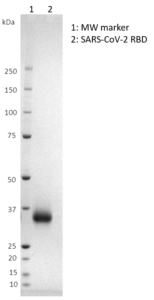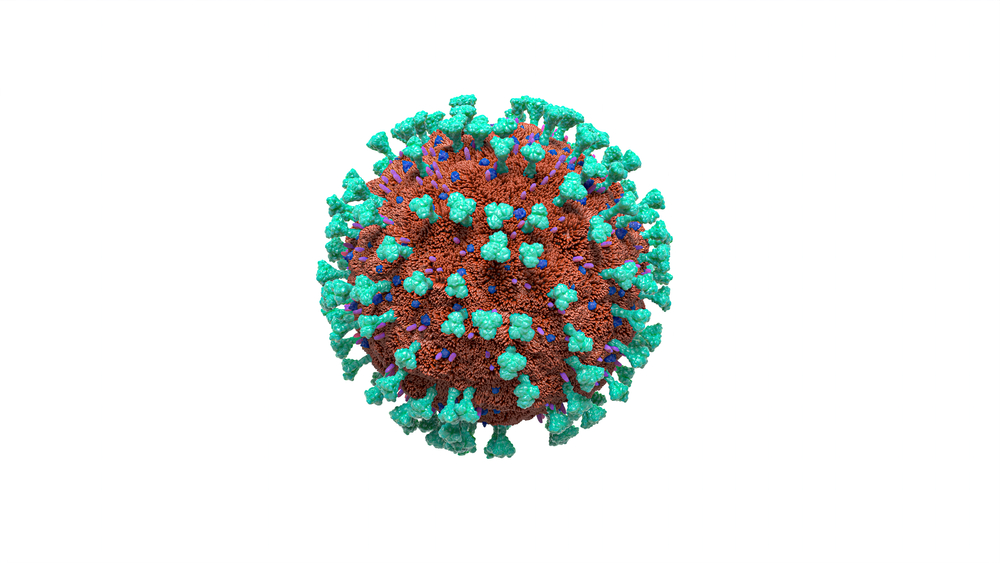
SDS-PAGE: Coomassie stained SDS-PAGE showing purified RBD protein.
SARS-CoV-2 Spike Glycoprotein (S1) RBD, His-Tag (HEK293)
$652.44 – $2,486.76 excl. VAT
SARS-CoV-2 Spike S1 RBD is a recombinant receptor-binding domain antigen, expressed in HEK293 cells and purified from culture supernatant with a His-tag to These proteins can be used as diagnostic standard antigens, targets of neutralizing antibodies and in the development of antibodies to detect SARS-CoV-2 in patients.
SARS-COV-2 SPIKE GLYCOPROTEIN (S1) RBD, HIS-TAG (HEK293)
SARS-CoV-2 Spike S1 RBD is a recombinant receptor-binding domain antigen, expressed in HEK293 cells and purified from culture supernatant with a His-tag to These proteins can be used as diagnostic standard antigens, targets of neutralizing antibodies and in the development of antibodies to detect SARS-CoV-2 in patients.
PRODUCT DETAILS – SARS-COV-2 SPIKE GLYCOPROTEIN (S1) RBD, HIS-TAG (HEK293)
- Recombinant SARS-CoV-2 Spike S1 RBD (aa 319-541), manufactured in HEK293 cells with His-tag.
- Contains Spike protein S1 subunit receptor-binding domain (NCBI Accession Number: 6XDG_E)
- SARS-CoV-2 Glycoprotein S1 RBD is purified to
- Presented as liquid in DPBS.
- RBD binds ACE2 (REC31876) when used as capture antigen in immunoassay (ELISA) at a concentration between 0.5-5.0 µg/ml.
BACKGROUND
SARS-CoV-2 is a respiratory virus which causes coronavirus disease 2019 (COVID-19). This disease spreads primarily through contact with an infected person via respiratory droplets generated when a person coughs or sneezes, or through droplets of saliva or discharge from the nose. Infection with SARS-CoV-2 can cause mild symptoms including a runny nose, sore throat, cough, and fever. However, it can be more severe for some people and can lead to pneumonia or breathing difficulties. The elderly, and people with pre-existing medical conditions (such as, diabetes and heart disease) appear to be more vulnerable to becoming severely ill with the virus (WHO, 2020).
The coronavirus spike (S) glycoprotein is a class I viral fusion protein on the outer envelope of the virion that plays a critical role in viral infection by recognizing host cell receptors and mediating fusion of the viral and cellular membranes (Li, 2016). Each monomer of trimeric S protein is about 180 kDa, and contains two subunits, S1 and S2, mediating attachment and membrane fusion, respectively. Two major domains in coronavirus S1 have been identified, the N-terminal domain (S1-NTD) and C-terminal domain (S1-CTD). Either or both of these S1 domains can function as a receptor-binding domain (RBD), depending on virus; SARS-CoV and MERS-CoV both use C-domain to bind their receptors (Ou et al., 2020). Angiotensin-converting enzyme 2 (hACE2)21 and human dipeptidyl peptidase 4 (hDPP4)22 have been identifies as the receptors for SARS-CoV and MERS-CoV, respectively. While S proteins of SARS-CoV-2 share about 76% amino acid identities with SARS-CoV, the amino acid sequence of potential RBD of SARS-CoV-2 is only about 74% homologous to that of SARS-CoV. It has been reported that human ACE2 is also the entry receptor of SARS-CoV-2, and that a serine protease is important for SARS-CoV-2 Spike activation (Hoffmann et al., 2020).
REFERENCES
- Hoffmann M, Kleine-Weber H, Schroeder S, et al. SARS-CoV-2 Cell Entry Depends on ACE2 and TMPRSS2 and Is Blocked by a Clinically Proven Protease Inhibitor. Cell. 2020;S0092-8674(20)30229-4.
- Li F. Structure, Function, and Evolution of Coronavirus Spike Proteins. Annu Rev Virol. 2016;3(1):237–261.
- Ou X, Liu Y, Lei X, et al. Characterization of spike glycoprotein of SARS-CoV-2 on virus entry and its immune cross-reactivity with SARS-CoV. Nat Commun. 2020;11(1):1620.
- Novel coronavirus (2019-nCoV), World health Organisation (WHO), 2020.

